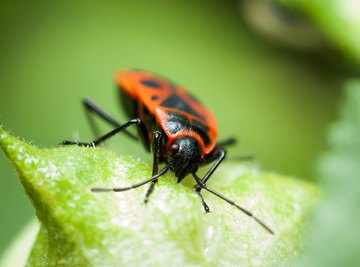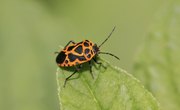
Boxelder bugs, (Boisea trivittatis), congregate in large numbers on the sides of homes and buildings to sun themselves. Populations explode after a number of warmer than usual winters becoming a nuisance to homeowners by their sheer numbers. There are few natural predators of these relatively harmless bugs and even fewer that homeowners want in their yards. Rodents, a limited number of other insects and a few bird species will eat boxelder bugs but there are a number of other control methods that can help reduce their numbers.
Why so few predators
Brown-black boxelder bugs sport red lines behind their heads, red veins in their wings and the abdomen beneath their wings is red. The red color acts as a warning to predators to avoid this food source as it could be poisonous or distasteful. Boxelder bugs produce an unpleasant odor when crushed, although they are not poisonous.
Rodents
Mice, rats, chipmunks and most of the other rodents will eat boxelder bugs. Even these rodents will not eliminate a large infestation as they will only eat a limited number at one time and only if a more desirable food source is not at hand.
Spiders, Praying Mantis and Wheel Bugs
Some species of spiders will eat boxelders as will praying mantis. Leave any spider webs intact near an infestation. Praying mantis are incredible predators that patiently stalk their prey then use their spiked front legs to snare it. Wheel bugs, called the assassins of the insect world, are named for the cog-like structure on their backs. One of the few insect predators of boxelder bugs, it injects its prey with enzyme-laden saliva to immobilize it and then sucks out the bug's body fluids.
Chickens, Ducks and Guinea Hens
About 10 percent to 15 percent of the diets of chickens and ducks is made up insects and they are known to eat boxelder bugs in limited quantities if other more desirable food sources are in short supply. The guinea hen, sometimes called a wild chicken, eats 90 percent insects and very little garden material. In a rural setting, guineas could help to naturally control boxelder bugs.
Other Control Methods
The most drastic measure to control boxelder bugs is removing the female boxelder trees they feed upon. Boxelder bugs can travel a good distance from their food source to a sunny house wall, so even this control may not work effectively. Keep bugs from getting inside by sealing any openings, like those around phone lines and outdoor facets, with caulking. Use a shop vacuum on the inside or outside of your home to vacuum up the bugs, emptying the canister into a plastic bag and sealing it tightly. Dousing the bugs with hot water is also effective.
References
About the Author
A writer with over 30 years of experience, Elaine Davidson began her career as a journalist in 1980 at Canadian Press. Her feature articles have appeared in many Canadian newspapers including "The Calgary Herald." Davidson has a Bachelor of Arts in English from Mount Allison University and a Master of Arts in journalism from University of Western Ontario.
